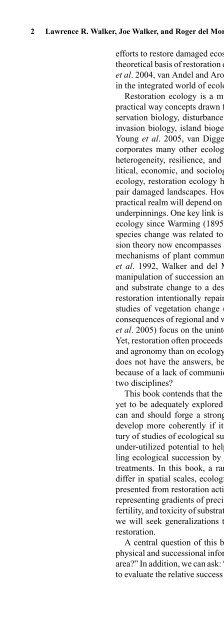Linking Restoration and Ecological Succession (Springer ... - Inecol
Linking Restoration and Ecological Succession (Springer ... - Inecol
Linking Restoration and Ecological Succession (Springer ... - Inecol
You also want an ePaper? Increase the reach of your titles
YUMPU automatically turns print PDFs into web optimized ePapers that Google loves.
2 Lawrence R. Walker, Joe Walker, <strong>and</strong> Roger del Moral<br />
efforts to restore damaged ecosystems. Several recent books have explored the<br />
theoretical basis of restoration ecology (Walker <strong>and</strong> del Moral 2003, Temperton<br />
et al. 2004, van Andel <strong>and</strong> Aronson 2006) <strong>and</strong> have better defined where it sits<br />
in the integrated world of ecology.<br />
<strong>Restoration</strong> ecology is a multidisciplinary approach that implements in a<br />
practical way concepts drawn from a wide range of disciplines, including conservation<br />
biology, disturbance ecology, ecological succession, ecohydrology,<br />
invasion biology, isl<strong>and</strong> biogeography, <strong>and</strong> l<strong>and</strong>scape ecology (Zedler 2005,<br />
Young et al. 2005, van Diggelen 2006). In addition, restoration ecology incorporates<br />
many other ecological themes, for example, biodiversity, habitat<br />
heterogeneity, resilience, <strong>and</strong> sustainability. <strong>Restoration</strong> often addresses political,<br />
economic, <strong>and</strong> sociological issues as well. As a new subdiscipline of<br />
ecology, restoration ecology has been driven primarily by the urgency to repair<br />
damaged l<strong>and</strong>scapes. However, the success of restoration ecology in the<br />
practical realm will depend on the strength of the ecological <strong>and</strong> process-based<br />
underpinnings. One key link is with ecological succession, a central concept in<br />
ecology since Warming (1895) <strong>and</strong> Cowles (1899 <strong>and</strong> 1901) recognized that<br />
species change was related to the time since stabilization on dunes. <strong>Succession</strong><br />
theory now encompasses a large set of concepts useful for explaining the<br />
mechanisms of plant community <strong>and</strong> ecosystem development (Glenn-Lewin<br />
et al. 1992, Walker <strong>and</strong> del Moral 2003). <strong>Restoration</strong> is fundamentally the<br />
manipulation of succession <strong>and</strong> frequently focuses on acceleration of species<br />
<strong>and</strong> substrate change to a desired endpoint (Luken 1990). While successful<br />
restoration intentionally repairs the processes driving succession, most other<br />
studies of vegetation change (e.g., global climate change, invasion biology,<br />
consequences of regional <strong>and</strong> watershed degradation, <strong>and</strong> gap dynamics; Davis<br />
et al. 2005) focus on the unintended factors that disrupt succession (Fig. 1.1).<br />
Yet, restoration often proceeds with more reliance on engineering, horticulture,<br />
<strong>and</strong> agronomy than on ecology (Young et al. 2005). Is this because succession<br />
does not have the answers, because restoration does not need succession, or<br />
because of a lack of communication or irreconcilable differences between the<br />
two disciplines?<br />
This book contends that the overlap between restoration <strong>and</strong> succession has<br />
yet to be adequately explored <strong>and</strong> that restoration <strong>and</strong> ecological succession<br />
can <strong>and</strong> should forge a stronger alliance than exists today. <strong>Restoration</strong> will<br />
develop more coherently if it better integrates ideas generated from a century<br />
of studies of ecological succession. Additionally, restoration has great but<br />
under-utilized potential to help elucidate the fundamental processes controlling<br />
ecological succession by monitoring how key system drivers respond to<br />
treatments. In this book, a range of restoration types will be identified that<br />
differ in spatial scales, ecological drivers, <strong>and</strong> restoration goals. Data will be<br />
presented from restoration activities around the world that come from habitats<br />
representing gradients of precipitation, temperature, soil age, <strong>and</strong> the stability,<br />
fertility, <strong>and</strong> toxicity of substrates. By exploring such contrasting environments,<br />
we will seek generalizations that link successional theory to the practice of<br />
restoration.<br />
A central question of this book is: “What is the minimum amount of biophysical<br />
<strong>and</strong> successional information needed to restore a specific l<strong>and</strong>scape or<br />
area?” In addition, we can ask: “What target values or indicators offer the means<br />
to evaluate the relative success or progress of particular restoration strategies?”

















